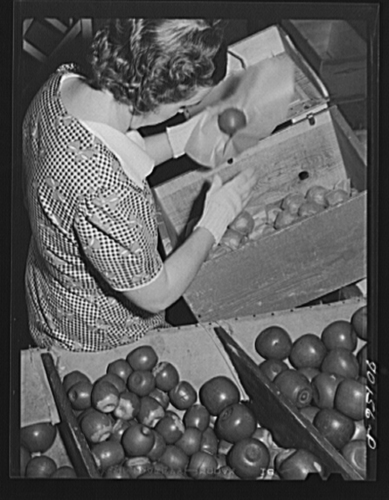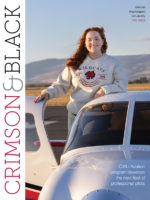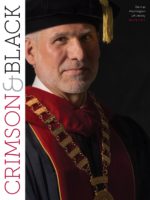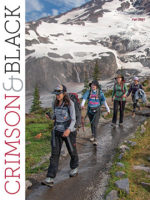
Apple pickers in the Yakima Valley in 1942.
In the fall of 1942, when hundreds of thousands of American men (between the ages of 18 and 37) had either been drafted into or enlisted in the military to fight in World War II, there was a labor shortage in apple orchards throughout Central Washington. To show their support for the war effort, and to assist regional farmers needing to pick the rapidly ripening crops, students voted to close school for three days so they could volunteer to harvest the apple crop.
“The word to us was that we had two choices: in order to get the apples in, we’re asking that you (students) go to the orchards (in my case, it was the town of Manson, north of Wenatchee) to pick apples,” said former student Louis E. Shandera in the book, Central Remembers. “But the dorms will close and if you choose not to go on the buses up where you will be fed and housed by the orchard owners, you will have to go home. The college will be closed.
“All the group I was going around with elected to pick apples,” he continued. “The girls got to stay in the main farmhouse. My roommate and I (he knew a little about apples, being from Naches) were assigned the clapboard shack down in the middle of the orchard—knot holes in the walls, a couple old cots to sleep on.”
Shandera, who was a student in the early 1940s and earned his master’s degree at Central in 1951, said the students would have to be up at 6 a.m. to pick apples.
“Ah sakes, it gets cold up there,” he said. “But we quickly figured it out! We’d have the firewood set on the stove at night. All one of us had to do when the alarm went off was to reach over with a match and light the fire in that pot-bellied stove. When the room started to get a little warm, we would get dressed and go up to the main house, where they would have this nice farm breakfast prepared for us.”
According to Shandera, the worst part of the job was that his hands would get so cold he couldn’t properly pinch the stem and twist the apple when picking the fruit. The best part, he recalled, was walking into town after working to get a soda and meet up with other Central students to share their stories.
“We received full credit for our classes (the curriculum just shifted to “How to pick apples”),” he said. “But the college provided the apple pickers and the crop that year was saved.”
Evelyn (Conant) Thompson, who graduated from Central in 1944, was elected the Homecoming Queen in 1942 and was given the authority to, in her words, “declare that all CWCE (Central Washington College of Education) students were to save the apple crop.”
Thompson explained, “No classes were to be held the following week. Since all the manpower was off to war, those students who agreed to were bused to Yakima and Wenatchee to pick apples. This was possibly the only time Central’s students were called on for such a project.”
Historian Samuel R. Mohler, author of The First Seventy-Five Years: A History of Central Washington State College, noted in that book that of the school’s 540 students and faculty, 375 volunteered for the “battle of the orchards” and were sent to pick apples in areas near Chelan, Yakima, Okanogan, and Ellensburg. He said they ultimately picked nearly 36,000 boxes of apples, most of which would have been lost since the cold weather came early that year.
So, surprisingly, the answer is yes.






comments powered by Disqus